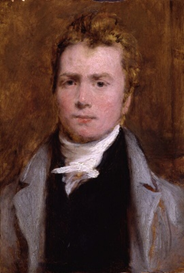Sir David Wilkie
1785-1841
Was born in Fife in Scotland on 18 November 1785, son of the parish minister of Cults, Fife. He developed a love for art at an early age. In 1799, after he had attended school at Pitlessie, Kingskettle and Cupar, his father reluctantly agreed to his becoming a painter. He had a habit of haunting fairs and marketplaces and transferring to his sketchbook all that struck him as characteristic and telling in figure or incident. In 1804, Wilkie returned to Cults He established himself in the manse there, and began his first important subject-picture, Pitlessie Fair, which includes about 140 figures, and in which he introduced portraits of his neighbours and of several members of his family circle. In 1822 Wilkie visited Edinburgh, in order to select from the Visit of King George IV to Scotland a fitting subject for a picture. The Reception of the King at the Entrance of Holyrood Palace was the incident ultimately chosen; and in the following year, when the artist, upon the death of Raeburn, had been appointed Royal Limner for Scotland, he received sittings from the Monarch, and began to work diligently upon the subject. But several years elapsed before its completion; for, like all such ceremonial works, it proved a harassing commission, uncongenial to the painter while in progress and unsatisfactory when finished. His health suffered from the strain to which he was subjected, and his condition was aggravated by heavy domestic trials and responsibilities. He was Principal Painter in Ordinary to King William IV and Queen Victoria. Apart from royal portraits, his best-known painting today is probably The Chelsea Pensioners reading the Waterloo Dispatch of 1822 in Apsley House. In the autumn of 1840 Wilkie resolved on a voyage to the East. Passing through Holland and Germany, he reached Constantinople, where, while detained by the war in Syria, he painted a portrait of the young sultan. He then sailed for Smyrna and travelled to Jerusalem, where he remained for some five busy weeks. The last work of all upon which he was engaged was a portrait of Mehemet Ali, done at Alexandria. On his return voyage he suffered from an attack of illness at Malta and remained ill for the remainder of the journey to Gibraltar, eventually dying at sea off Gibraltar, en route to Britain, on the morning of 1 June 1841. His body was consigned to the deep in the Bay of Gibraltar.
